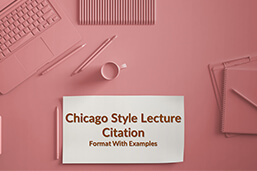
The Chicago Manual of Style provides a specific framework for citing sources. When referencing a lecture, it typically falls under the category of “non-concurrent” or “unpublished” sources. According to the Chicago style, you need to include the speaker’s name, the title of the lecture in quotation marks (or a description if there’s no formal title), the event’s name, its location, and the date of the lecture. The citation structure varies depending on whether it’s included in the bibliography or used as an in-text citation. Discover more details in this article.
Definition: Chicago style lecture citation
Chicago style lecture citation requires using footnotes for in-text citations and a list of entries in the bibliography. Since you are citing lectures or speeches, you need to describe the media. For a lecture in a classroom, writers must include the lecturer’s name, title, lecture, event, location, and date.
in Your Thesis
Chicago style lecture citation: Examples
Chicago style lecture citation: Google Slides, PowerPoint, etc.
When using Chicago style lecture citation to cite information in a PowerPoint presentation or Google slides, ensure you include the media. Here are the examples:
Chicago style lecture citation: Transcription
When citing a transcribed speech using the Chicago style lecture citation, follow the format appropriate to the source, starting with the speaker’s name. A transcript on a book will have publisher details, while a transcript on a website will have a URL.
Chicago style lecture citation: Recording
Using Chicago style lecture citations for recording uses the same format as the transcription.
Chicago style lecture citation: No date
When you are citing the Chicago style lecture citation and there is no date listed for the lecture you reference, use the initials n.d. instead.
When the author or the lecturer isn’t listed in Chicago style lecture citation, start the citation with the lecture or speech title. As shown below:
Chicago style lecture citation: Author-date style
In Chicago style lecture citation, you can cite speeches, transcribed speeches and recorded lectures using the author-date style. The reference list entries are similar to the bibliography format except for the Year. Here are examples:
| Lecture citation | Lecture delivered via Google Slides, PowerPoint, etc. | Transcribed lecture | Recorded lecture | |
| Chicago author-date format | Speaker's last name, first name. Year. "Lecture title." Lecture, Institution name, location, month day, year. | Last name, first name. Year. “Lecture or presentation title.” PowerPoint presentation, university or conference name, location, month date, Year of presentation. | Author’s last name, first name. Year. “Speech title.” In Book Title: Subtitle, edited by editor first name last name, page range. Place of publication: publisher, Year. | Speaker's last name, first name. Year. "Speech Title." Recorded at location, month day, Year. |
| Chicago reference entry | Elton, James. 2014. “The Effects of the Russian Civil War.” Lecture, New York University, New York, NY, March 19, 2014. | Roberts, Norah. 2018. “Importance of Fish in the Ecosystem.” PowerPoint presentation, University of Dallas, Texas, June 9, 2018. | Smith, John. 2016. “The Effects of Depression.” In The Penguin Book of Modern Speeches, edited by Theodore Roosevelt, 6-10. Birmingham: Penguin, 2016. | Luther Martin. 1970. “I have a Dream” Recorded at Lincoln, Washington, September 28, 1970. |
| Chicago author-date citation | (Elton 2014) | (Roberts 2018) | (Smith 2016) | (Luther 1970) |
FAQs
When you are citing a recorded speech in Chicago style lecture citation, you must mention the place of recording and the website it was posted.
If the date is not listed, list n.d. in place of the date when you create a reference list using the Chicago style citation for lecture.
You can start with the speech title and stick to the bibliography or author-date format in Chicago lecture citation.
